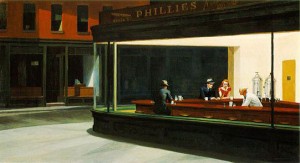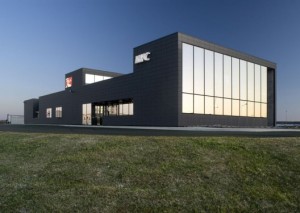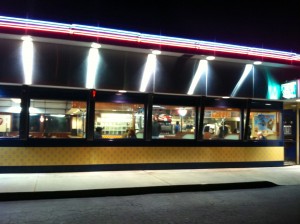Thoughts on fast-food architecture at Zesto, following a faux-heart attack
Around 1987, during my second stint as editor of Creative Loafing, I decided the paper needed an architecture critic. I’d returned to Atlanta after two years in Houston where I’d become fascinated with the subject. The magazine I edited there regularly ran architecture criticism.
So I put out the word and received a good bit of interest from some really forward-thinking architects. I asked most of the candidates to write the same essay – a critical review of John Portman’s Peachtree Center designs (c. 1967). The number willing to write that? Zero. It wasn’t because they liked Portman’s style. It was because they didn’t want to commit career suicide by hurling Portman’s reputation from the top balcony of the Hanging Gardens of Atlanta Hyatt Regency.
Atlanta generally is cursed with a lot of hideous architecture. The building booms of the ’60s and ’70s here destroyed much of the city’s outward beauty. And that wasn’t uncalculated, especially downtown. More about that in a moment.
* * *
One of the longtime blights upon our landscape – and increasingly around the world – is fast-food architecture. I was thinking about that one night last week when I decided to reward myself after not having what I thought was a heart attack (seriously) the day before. It was about 11 p.m., I think, and I needed a Toffee Coffee Arctic Swirl from Zesto to remind me of life’s sweetness. (Actually, any excuse will do.)
 As I approach the Retro Zesto on Ponce (above) I notice how each window frames a view of separate tables. Somehow, that reminds me instantly of Edward Hopper’s painting, “Nighthawks” (1942) (left). I suppose the association is the nighttime view through windows of two diners. Of course, Zesto is actually flashy as hell looked at overall, whereas Hopper’s venue is non-descript.
As I approach the Retro Zesto on Ponce (above) I notice how each window frames a view of separate tables. Somehow, that reminds me instantly of Edward Hopper’s painting, “Nighthawks” (1942) (left). I suppose the association is the nighttime view through windows of two diners. Of course, Zesto is actually flashy as hell looked at overall, whereas Hopper’s venue is non-descript.
Fast-food joints are flashy to catch attention, obviously, and we all know beauty doesn’t snare the American imagination as much as flagrant kitsch. Believe me, when those golden arches first appeared – as literal parts of McDonald’s architecture – they stabbed us in the salty gut and the hungry eyes. Obviously, too, the standardization of such design adds to recognition among the competing fast food emporia that snake along America’s highways. (Interestingly, though, Zesto has some seriously deviant designs that go beyond flashy to hilarious kitsch. Check out the Buckhead pagoda, if you haven’t.)
Besides catering to Americans’ low-grade aesthetics, fast-food architecture serves other purposes in my experience. Most fast-food restaurants conform to at least one standard of horror prevalent in Portman’s own architecture: elimination of the nooks and crannies of semi-private space that used to be part of architecture. I’m sure you can deduce why in the riot-plagued mid-’60s, Atlanta’s new downtown architecture was conceived to put everything in public view and provide no full-time residency. Thus we’ve never enjoyed the kind of downtown street life that characterizes larger, older American cities and most of the European continent.
In this context, there’s a little-acknowledged payoff in fast-food restaurants. As I near the door, my gaze meets that of others, each window a vaguely melancholy vignette. But when I get inside the harshly lit restaurant and join the short line, I’m immediately engaged in conversation with the interracial couple from New York in front of me. I’m proselytizing the curative powers of Toffee Coffee Arctic Swirls, which they decide to try and later tell me has changed their lives. “And we love the way the black is swirled with the white right here in Dixie,” the woman tells me, laughing.
I’m wearing my Pink Floyd t-shirt. As I walk to my table, three men with Bibles call me over and we start discussing the band. The shirt is illustrated with the band’s mascot pig and we get into a discussion about whether it’s a relevant image, as seems to happen every time I wear it. We start browsing our phones faster than Sunday School kids doing Bible drills.
Then a woman sitting alone at a nearby table shouts that Pink Floyd is her favorite band ever and that, yes, of course, the pig is the sine qua non of PF imagery. We high-five. The trio laughs and reopens their Bibles. One of them gives me what I assume is a business card.
I finally sit down with my ice cream. I look at the card. It says, “This entitles you to never-ending blessings from Jesus Christ.” Whoa! Bring on the cash, Big Guy.
 A man and woman with an infant enter and take seats at a bar across from me. The baby is slapping its carrier and smiling between sips from a bottle. Four teenagers come in. Two are wrapped around one another like Siamese twins attached face-to-face and hip-to-hip. They break loose and walk toward my table. The guy stops.
A man and woman with an infant enter and take seats at a bar across from me. The baby is slapping its carrier and smiling between sips from a bottle. Four teenagers come in. Two are wrapped around one another like Siamese twins attached face-to-face and hip-to-hip. They break loose and walk toward my table. The guy stops.
“So you like that Kindle?” he asks in a deeply country accent. “How come you didn’t get an iPad?”
“For the same reason I’m eating at Zesto,” I say. He laughs. I ask where they’re from.
They are from Macon, up for a concert. I ask him if Len Berg’s, famous for its macaroon pie, is still open there. I used to stop there whenever convenient during the years I dined around the state for Georgia Trend magazine. He looked at me blankly. His girlfriend walked over and said, “Oh, my mama talks about that place! So does my grandma.” Thank you for making me feel decrepit.
One by one, everyone leaves the restaurant as others enter, many laughing as they walk through the doors. Bromides about ships passing in the night and conversations with strangers on airplanes go through my head. Outside, apparently homeless people mill about. One asks me if I have an extra French fry. “I’m out of those,” I say and give him a dollar.
* * *
It seems absurd to think that these overlit palaces of unhealthy, mainly bad-tasting food serve the purpose of public plazas. But they certainly are rooted in the tradition of roadside restaurants, diners and coffee shops where friends’ conversation overflows to strangers’ tables. Indeed, Starbucks — no matter how much you may hate it — serves that purpose big-time, especially with its newish community tables.
I spent two years soon after undergrad as editor of the McDuffie Progress in Thomson, Georgia, and I remember when the McDonald’s opened there, barely a block off the I-20 exit. It was a shock to the town, which had the usual spots where people gathered for morning coffee and cat-head biscuits. McDonald’s is not usually considered a hangout space, but I do remember lots of Thomson people commenting that the restaurant was, essentially, a landing pad for aliens — a good place for people-watching if not actual conversation.
But, if you think McDonald’s never functions as a community plaza, visit the one on Cheshire Bridge. At some hours, it’s full of mainly Mexican kids on laptops, taking advantage of the free WiFi. (And isn’t Facebook itself a public plaza?) The kids are often with their mothers. I got to practice my Spanish the couple times I went there to sample the repulsive McRib. “Como se dice ‘chicken finger’ en Español?”
Happily, in some areas of the world, fast food venues are acquiring aesthetics more suited to hanging out and don’t overwhelm their architectural context. One of the most remarkable is the KFC in Keflavík, Iceland (photo above-right).
You typically do not interact with those not seated at your table in most “serious” restaurants, although the bar does provide that opportunity and community tables are becoming more popular. I love ai3’s designs because the firm really does think in strong terms about the social aspect and ‘flow’ of dining out. (And I’m remiss in not posting an interview I did with the firm months ago.)
My longtime socialist conscience has to note, though, that democracy is not at play in high-end restaurants or fast-food venues, for that matter. Most restaurants are vessels of classism. Maybe that’s true of all capitalist businesses, but I’m advocating transgression of social boundaries. That’s one reason I love small ethnic restaurants like those along Buford Highway. Their very alterity and low prices especially create a sense of the public plaza. They are typically as kitschy as fast-food chains, but at their best they are full of soul.
* * *
My parents lived in St. Simon’s and I had occasion once to visit John Portman’s home there, Entelechy 2. It was different from his weirdly hotel-like Atlanta home, Entelechy 1, but grotesquely Disneyesque to my eyes, and not mindful of its location. There’s no doubt the man is a brilliant rebel who has influenced architecture worldwide. But the cinematic scale displaces intimacy, perfect for anyone who wants to avoid the sight of poverty or open the eyes to the heart of diversity.
How utterly weird to think that trashy fast-food joints might constitute a homeopathic antidote to bland grandeur. Well, that’s the crazy way I think at Zesto late at night in the thrall of a Toffee Coffee Arctic Swirl after surviving a faux heart attack, anyway.
Oh, that “heart attack” turned out to be the result of an act of stupidity I committed in the gym.

There are 2 Comments to "Thoughts on fast-food architecture at Zesto, following a faux-heart attack"
Fun essay! Glad you didn’t drop dead. Seriously, I so wish you’d write more like this. You’ve got half a dozen books in you, and you’ve got something that so many writers don’t — a heart. Anyway, you already know how I feel.
Ditto what Paula says and, if anything, you’ve understated how awful the architecture in Atlanta is. I did like that blue space ship thingy on top of the Regency. It’s been 15 years since I lived there, so maybe things have gotten better. Cheers from Vancouver, CB.